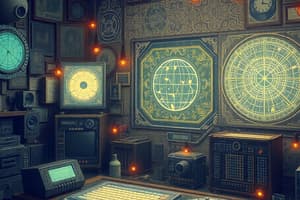Podcast
Questions and Answers
Which of the following best describes the primary function of a sensor?
Which of the following best describes the primary function of a sensor?
- To detect and measure physical properties, converting them into electrical signals. (correct)
- To convert mechanical energy into electrical energy.
- To amplify electrical signals for further processing.
- To control the flow of electrical current in a circuit.
In industrial furnaces, what role do temperature sensors play?
In industrial furnaces, what role do temperature sensors play?
- Regulating the speed of conveyor belts.
- Optimizing energy consumption by adjusting lighting.
- Ensuring proper heating levels for industrial processes. (correct)
- Ensuring workers' safety by detecting gas leaks.
How do motion sensors contribute to cost reduction in smart lighting systems?
How do motion sensors contribute to cost reduction in smart lighting systems?
- By detecting and reporting equipment malfunctions.
- By adjusting the color of lights to match the time of day.
- By turning off lights when no one is present. (correct)
- By increasing the brightness of lights during peak hours.
Which of the following is an example of how sensors are used for predictive maintenance?
Which of the following is an example of how sensors are used for predictive maintenance?
In the context of 'Industry 4.0', what is enabled by advanced automation that uses AI-driven sensors?
In the context of 'Industry 4.0', what is enabled by advanced automation that uses AI-driven sensors?
Which type of sensor is commonly used for non-contact temperature measurements?
Which type of sensor is commonly used for non-contact temperature measurements?
What principle do strain gauge sensors use to measure pressure?
What principle do strain gauge sensors use to measure pressure?
Where are gyroscopes typically used to measure angular velocity?
Where are gyroscopes typically used to measure angular velocity?
Which type of proximity sensor is best suited for detecting metal objects?
Which type of proximity sensor is best suited for detecting metal objects?
How does the resistance of an LDR (Light Dependent Resistor) change with increasing light intensity?
How does the resistance of an LDR (Light Dependent Resistor) change with increasing light intensity?
Which of the following gases can be detected using MQ series sensors?
Which of the following gases can be detected using MQ series sensors?
What type of humidity sensor changes capacitance based on the moisture content in the air?
What type of humidity sensor changes capacitance based on the moisture content in the air?
What is the measurement principle of ultrasonic flow sensors?
What is the measurement principle of ultrasonic flow sensors?
What is the main application of glucose sensors?
What is the main application of glucose sensors?
Which of the following is an example of a sensor that operates based on the electromechanical principle?
Which of the following is an example of a sensor that operates based on the electromechanical principle?
Which category of sensors includes thermocouples and infrared sensors?
Which category of sensors includes thermocouples and infrared sensors?
What distinguishes active sensors from passive sensors?
What distinguishes active sensors from passive sensors?
Which type of sensor produces continuous signals?
Which type of sensor produces continuous signals?
Which application primarily utilizes environmental sensors?
Which application primarily utilizes environmental sensors?
In which sector are ECG and EEG sensors commonly used?
In which sector are ECG and EEG sensors commonly used?
How do position sensors contribute to automation in robotic arms within manufacturing?
How do position sensors contribute to automation in robotic arms within manufacturing?
What is the primary function of gas leakage sensors in chemical plants?
What is the primary function of gas leakage sensors in chemical plants?
Which of the following sensors converts light directly into electrical current?
Which of the following sensors converts light directly into electrical current?
What is the distinguishing characteristic of sensors categorized under 'Based on Output Type'?
What is the distinguishing characteristic of sensors categorized under 'Based on Output Type'?
What role do turbine flow sensors play in monitoring fuel flow?
What role do turbine flow sensors play in monitoring fuel flow?
Flashcards
What is a sensor?
What is a sensor?
A device that detects and measures physical properties from the environment and converts them into electrical signals for further processing.
Real-Time Monitoring & Control
Real-Time Monitoring & Control
Sensors continuously collect data about the environment.
Improved Accuracy & Precision
Improved Accuracy & Precision
Machines equipped with sensors can perform tasks with minimal errors.
Increased Efficiency & Productivity
Increased Efficiency & Productivity
Signup and view all the flashcards
Enhanced Safety & Hazard Detection
Enhanced Safety & Hazard Detection
Signup and view all the flashcards
Energy Savings & Cost Reduction
Energy Savings & Cost Reduction
Signup and view all the flashcards
Predictive Maintenance & Reduced Downtime
Predictive Maintenance & Reduced Downtime
Signup and view all the flashcards
Human-Free Operation (Industry 4.0)
Human-Free Operation (Industry 4.0)
Signup and view all the flashcards
Actuators
Actuators
Signup and view all the flashcards
Temperature Sensors
Temperature Sensors
Signup and view all the flashcards
Thermocouples
Thermocouples
Signup and view all the flashcards
RTDs (Resistance Temperature Detectors)
RTDs (Resistance Temperature Detectors)
Signup and view all the flashcards
Infrared (IR) Sensors
Infrared (IR) Sensors
Signup and view all the flashcards
Pressure Sensors
Pressure Sensors
Signup and view all the flashcards
Strain Gauge Sensors
Strain Gauge Sensors
Signup and view all the flashcards
Piezoelectric Sensors
Piezoelectric Sensors
Signup and view all the flashcards
Motion & Position Sensors
Motion & Position Sensors
Signup and view all the flashcards
Gyroscopes
Gyroscopes
Signup and view all the flashcards
Hall Effect Sensors
Hall Effect Sensors
Signup and view all the flashcards
Proximity Sensors
Proximity Sensors
Signup and view all the flashcards
Inductive Sensors
Inductive Sensors
Signup and view all the flashcards
Capacitive Sensors
Capacitive Sensors
Signup and view all the flashcards
Ultrasonic Sensors
Ultrasonic Sensors
Signup and view all the flashcards
Light Sensors
Light Sensors
Signup and view all the flashcards
LDR (Light Dependent Resistor)
LDR (Light Dependent Resistor)
Signup and view all the flashcards
Study Notes
- A sensor is a device used to detect and measure physical properties (temperature, pressure, light, motion) from the environment.
- Sensors convert these properties into electrical signals for processing.
Need for Sensors
- Real-time monitoring and control is achieved through the continuous collection of environmental data (temperature, pressure, speed) by sensors.
- Temperature sensors in industrial furnaces are an example of real-time monitoring to ensure proper heating levels.
- Improved accuracy and precision is achieved because machines with sensors perform tasks with minimal errors.
- Position sensors in robotic arms provide accurate assembly in manufacturing.
- Increased efficiency and productivity is achieved because sensors allow machines to work faster without human supervision.
- Automated warehouses use barcode scanners and RFID sensors.
- Enhanced safety and hazard detection uses sensors to detect potential dangers and prevent accidents.
- Gas leakage sensors in chemical plants are used to alert workers before an explosion.
- Energy savings & cost reduction occurs because Sensors optimize resource usage, reducing waste and operational costs.
- Motion sensors turn off lights when no one is around.
- Predictive maintenance & reduced downtime uses sensors to monitor machine health and detect faults before failures occur.
- Vibration sensors are used to detect early signs of mechanical failure in engines.
- Human-free operation (Industry 4.0) happens because advanced automation with Al driven sensors enables self-operating factories.
- Autonomous robots in car manufacturing perform welding and assembly.
Classification of Sensors
- Sensors are classified based on measured parameter, working principle, power requirement, output type, and application.
Based on Measured Parameter
- Sensors are categorized based on the physical quantity they measure.
Temperature Sensors
- They measure temperature changes in an environment or object.
- Thermocouples work based on the Seebeck effect which has temperatures that change with voltage.
- K-type thermocouples are used in furnaces and engines.
- RTDs (Resistance Temperature Detectors) are resistance changes with temperature.
- PT100 sensors are used in industrial processes.
- Infrared (IR) Sensors detect thermal radiation and are used in non-contact thermometers and thermal cameras.
Pressure Sensors
- They measure force per unit area exerted by a fluid or gas.
- Strain Gauge Sensors use resistive material that changes resistance under pressure.
- They are used in digital weight scales.
- Piezoelectric Sensors generate voltage under pressure.
- They are used in microphones and sonar.
Motion and Position Sensors
- Detect motion, acceleration, and angular velocity.
- Gyroscopes measure angular velocity and are used in drones, robotics, and VR systems.
- Hall Effect Sensors detect magnetic field changes for position sensing.
- They are used in brushless motors and speed sensors.
Proximity Sensors
- Detect the presence or absence of an object without contact.
- Inductive Sensors detect metal objects using electromagnetic fields and are used in automotive ABS systems.
- Capacitive Sensors detect non-metallic objects via changes in capacitance and are used in touchscreens and level measurement.
- Ultrasonic Sensors use sound waves to detect distance and are used in parking sensors and robotics.
- Laser proximity Sensors use laser beams to precisely detect objects at longer distances.
- They are used in robotics, industrial automation and 3D scanning.
Light Sensors
- Measures light intensity and wavelength.
- Photodiodes convert light into current and are used in solar panels and fiber optics.
- LDR (Light Dependent Resistor) has resistance that decreases with more light.
- They are used in street lights and auto-dimming
- IR Sensors detect infrared radiation and are used in remote controls and motion detectors.
Gas Sensors
- Detect the presence of gases and their concentration.
- MQ Series Sensors detect different gases like MQ-2 (smoke), MQ-7 (CO), MQ-135 (air quality).
- Electrochemical Sensors measure gas concentration using chemical reactions and they are found in CO detectors.
Humidity Sensors
- Measure moisture content in the air.
- Capacitive Humidity Sensors have changes in capacitance based on moisture.
- The DHT11 and DHT22 sensors are used in weather monitoring.
Flow Sensors
- Measure the rate of fluid or gas flow.
- Ultrasonic Flow Sensors use sound waves and are used in water meters.
- Turbine Flow Sensors use a rotating turbine to measure flow and are used in fuel flow meters.
Biosensors
- Detect biological parameters.
- Glucose Sensors detect blood sugar levels and are used in diabetes monitoring.
- PH Sensors measure acidity or alkalinity.
- Applications include agriculture and the food industry.
- EEG Sensors measure brain activity and are used in medical research.
Based on Working Principle
- Sensors operate using different principles.
- Electromechanical Sensors convert mechanical movement into electrical signals like a strain gauge and MEMS accelerometers.
- Optical Sensors detect changes in light like photodiodes and IR sensors.
- Capacitive Sensors change capacitance to detect objects like touchscreens and humidity sensors.
- Inductive Sensors generate electromagnetic fields to detect metals like metal detectors and proximity sensors.
- Piezoelectric Sensors generate voltage when pressure is applied like microphones and vibration sensors.
- Thermal Sensors detect temperature variations like thermocouples and infrared sensors.
Based on Power Requirement
- Active Sensors require an external power source like Ultrasonic Sensors, Thermistors.
- Passive Sensors generate their own signals without external power like Thermocouples, LDRs.
Based on Output Type
- Analog Sensors produce continuous signals like RTD, LDR.
- Digital Sensors produce discrete signals (0 or 1) like IR proximity sensors and Digital Temperature Sensors like DS18B20.
Based on Application
- Environmental Sensors are used in weather stations and pollution monitoring like humidity and air quality sensors.
- Automotive Sensors are used in vehicles for safety and automation like ABS sensors and oxygen sensors.
- Medical Sensors are used in healthcare applications like ECG and EEG sensors.
- Industrial Sensors are used in automation and manufacturing like pressure and vibration sensors.
Studying That Suits You
Use AI to generate personalized quizzes and flashcards to suit your learning preferences.





